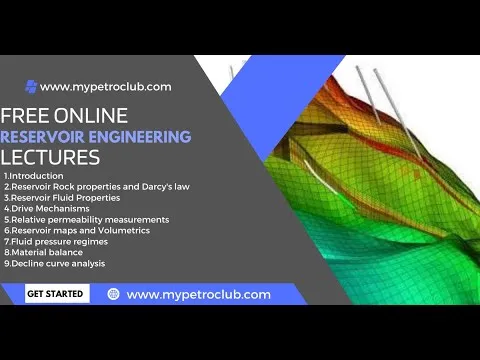
Petrophysical Analysis In Techlog 
Learn how to perform essential Petrophysical Analysis using Schlumberger Techlog Software in this comprehensive course. Designed for beginners, this course is perfect for professionals in the Oil & Gas industry, students, and recent graduates studying Petrophysics and Formation Evaluation. Gain hands-on experience with actual well data and learn how to navigate Techlog in no time. By the end of the course, you'll be able to set up projects, load and QC data, and perform Petrophysical analysis such as Shale volume calculation, Porosity Calculation, and water saturation calculation from well logs. Perfect for subsurface geoscientists, petroleum industry professionals, and graduate students, this course is a must for anyone looking to strengthen their Techlog skills and pursue a career in the Oil & Gas industry. ▼
ADVERTISEMENT
Course Feature
![]() Cost:
Cost:
Paid
![]() Provider:
Provider:
Udemy
![]() Certificate:
Certificate:
Paid Certification
![]() Language:
Language:
English
![]() Start Date:
Start Date:
2022-05-19
Course Overview
❗The content presented here is sourced directly from Udemy platform. For comprehensive course details, including enrollment information, simply click on the 'Go to class' link on our website.
Updated in [September 19th, 2023]
What does this course tell?
(Please note that the following overview content is from the original platform)
What you'll learn TechlogData LoadingWell Logs (Las, Asci)Well Tops/ZonesWell Logs Display + QCLog View (Templet setting)Build Harmonized DatasetPrecomputationsTemperature CalculationRw CalculationWell Logs InterpretationVsh (Shale Volume calculation)Porosity calculationSw (Water Saturation Calculation)Cutoffs (Vsh,Porosity,Sw)SummariesRequirements· Nothing special is Require This course is design for new users (Beginner level)For Maximum BenefitsSome Knowledge of Petrophysics or Formation EvaluationInstalled Techlog SoftwareDescriptionIn this course, you would figure out how to perform essential Petrophysical Analysis with actual well data by utilizing Schlumberger Techlog Software. This is generally helpful to Oil & Gas industry professionals, students and new alumni that have enrolled in a class to study Petrophysics and additionally Formation Evaluation.· Figure out how to explore a main Oil and Gas industry Software - Techlog in practically no time.· Practice with Actual Project Data Carryout Petrophysical AnalysisAt the end of this course, Student would be able to:· Setup project in Techlog· Load and QC data· Petrophysical analysis like Shale volume calculation, Porosity Calculation & water saturation calculation from well logsWho this course is for:Who want to learn basic Techlog skillsWho want to strengthen existing Techlog skillsSubsurface Geoscientists who Use and Interpret Well Logs dataPetroleum Industry Technical ProfessionalsGraduate students who want to use TechlogAnyone who wants to learn basic seismic interpretation methods and techniquesFresh Graduates in Petroleum Geoscience, Geology, Geophysics with background knowledge of Petrophysics and/or Formation EvaluationAnd Anyone who want to learn and want to pursue career in Oil & Gas industryWe consider the value of this course from multiple aspects, and finally summarize it for you from three aspects: personal skills, career development, and further study:
(Kindly be aware that our content is optimized by AI tools while also undergoing moderation carefully from our editorial staff.)
What skills and knowledge will you acquire during this course?
During this course, the learner will acquire the skills and knowledge necessary to perform basic Petrophysical Analysis using Schlumberger Techlog Software. They will learn how to navigate and utilize the software effectively, as well as practice with actual well data to carry out Petrophysical Analysis.
Specific skills and knowledge that will be acquired include:
1. Data Loading: The learner will learn how to load well logs in various formats (Las, Asci) into the Techlog software.
2. Well Logs Display and QC: They will learn how to display and quality check the well logs, ensuring that the data is accurate and reliable.
3. Log View and Templet Setting: The learner will gain knowledge on how to customize the log view and set templates for efficient analysis.
4. Harmonized Dataset: They will learn how to build a harmonized dataset by integrating different well log data.
5. Precomputations: The learner will acquire the skills to perform precomputations such as temperature and Rw (water resistivity) calculations.
6. Well Logs Interpretation: They will learn how to interpret well logs to calculate important parameters such as shale volume (Vsh), porosity, and water saturation (Sw).
7. Cutoffs: The learner will understand the concept of cutoffs and how to apply them in Petrophysical Analysis for parameters like Vsh, porosity, and Sw.
8. Summaries: They will learn how to generate summaries of the Petrophysical Analysis results for reporting and decision-making purposes.
By the end of the course, the learner will be able to set up a project in Techlog, load and quality check data, and perform Petrophysical Analysis tasks such as shale volume calculation, porosity calculation, and water saturation calculation from well logs. This course is designed for beginners and is beneficial for professionals in the oil and gas industry, students and graduates studying Petrophysics and Formation Evaluation, subsurface geoscientists, petroleum industry technical professionals, and anyone interested in pursuing a career in the oil and gas industry.
How does this course contribute to professional growth?
This course, "Petrophysical Analysis In Techlog," contributes significantly to professional growth by providing individuals with the necessary skills and knowledge to perform essential petrophysical analysis using Schlumberger Techlog Software. By enrolling in this course, professionals, students, and new graduates in the oil and gas industry can enhance their understanding of petrophysics and formation evaluation.
Through this course, individuals will learn how to navigate and utilize Techlog, a widely used software in the oil and gas industry, in a short period of time. They will have the opportunity to practice with actual project data, allowing them to gain hands-on experience in carrying out petrophysical analysis.
By the end of the course, students will be able to set up projects in Techlog, load and quality check data, and perform various petrophysical analyses such as shale volume calculation, porosity calculation, and water saturation calculation from well logs. These skills are highly valuable in the oil and gas industry, as they are essential for reservoir characterization and evaluation.
This course is suitable for individuals who want to learn basic Techlog skills or strengthen their existing Techlog skills. It is particularly beneficial for subsurface geoscientists who use and interpret well logs data, petroleum industry technical professionals, and graduate students in petroleum geoscience, geology, and geophysics. Additionally, fresh graduates with a background knowledge of petrophysics and/or formation evaluation who are interested in pursuing a career in the oil and gas industry can greatly benefit from this course.
Overall, this course provides individuals with the necessary skills and knowledge to effectively utilize Techlog software and perform essential petrophysical analysis. By acquiring these skills, professionals can enhance their career prospects and contribute to the success of their organizations in the oil and gas industry.
Is this course suitable for preparing further education?
Yes, this course is suitable for preparing further education in the field of Petrophysics and Formation Evaluation. It is designed for new users at a beginner level, making it accessible for students and new graduates who are studying these subjects. The course covers essential Petrophysical Analysis using actual well data and the Schlumberger Techlog Software, which is widely used in the Oil & Gas industry. By the end of the course, students will be able to set up projects, load and quality check data, and perform Petrophysical analysis such as shale volume calculation, porosity calculation, and water saturation calculation from well logs. This course is beneficial for subsurface geoscientists, petroleum industry technical professionals, graduate students, and anyone interested in pursuing a career in the Oil & Gas industry.
Course Syllabus
Introduction
Data Loading
Well Log DIsplay & Template Setting
Zonation / Well Tops import & Display Properties
Precomputation for Petrophysical Analysis
Petrophysical Analysis Complete Workflow
Course Provider

Provider Udemy's Stats at AZClass
Discussion and Reviews
0.0 (Based on 0 reviews)
Explore Similar Online Courses

Reservoir Engineering Fundamentals

Basic Reservoir Engineering

Python for Informatics: Exploring Information

Social Network Analysis

Introduction to Systematic Review and Meta-Analysis

The Analytics Edge

DCO042 - Python For Informatics

Causal Diagrams: Draw Your Assumptions Before Your Conclusions

Whole genome sequencing of bacterial genomes - tools and applications

Applied Reservoir Engineering (Reservoir Simulation with PETREL and ECLIPSE ( Petrel RE) e-Course
![[Webinar]: 10 Reservoir Engineering Analyses](/ccsimg/dcs/img_tools/b16992e609b47d9f806ebae60ee1b38d.webp)
[Webinar]: 10 Reservoir Engineering Analyses


Start your review of Petrophysical Analysis In Techlog